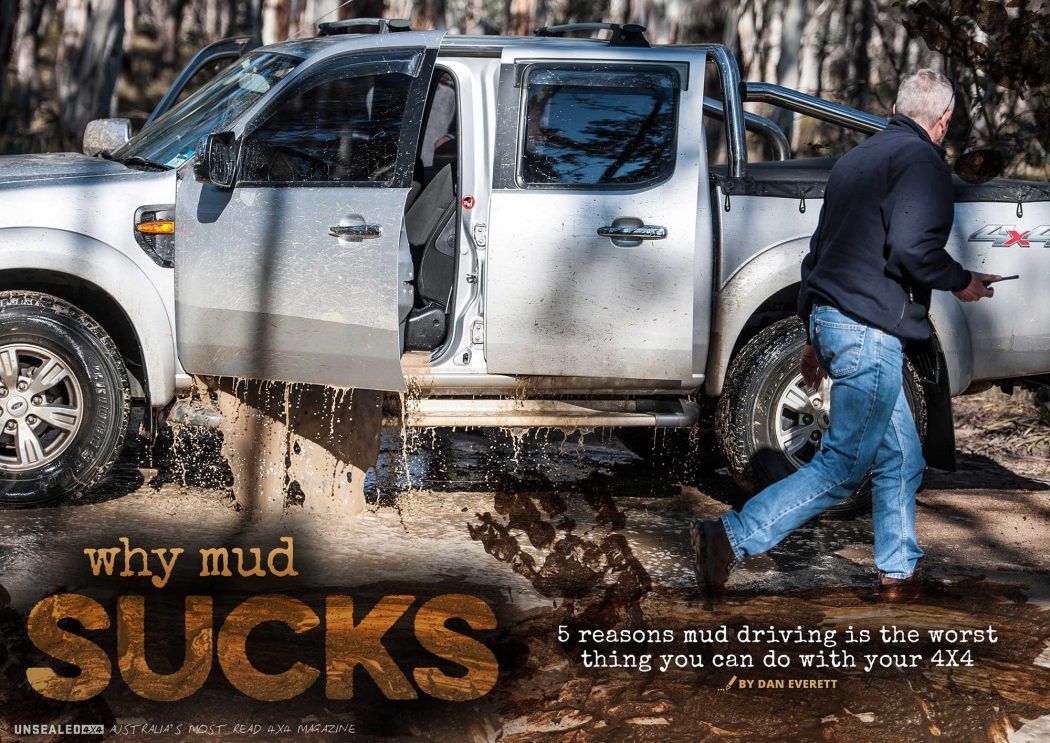Five reasons mud driving is the worst thing you can do with your 4X4
Off-road driving means a lot of different things to a lot of different people. For some it’s the pure isolation touring provides. Travelling thousands of kilometres just to find that piece of untouched beauty. For others, it’s the technical challenge of rocks – travelling barely more than a few kilometres in a full day but testing their vehicle and their skills. Some find a 4X4 gives them the freedom to get away with the family for some quality bonding time, while others use it as an escape from society completely. Then there’s the mud drivers. They’re an odd bunch, and fortunately mostly comprised of those who are too new to know better. But putting it politely, mud is a bit like that creepy uncle who always turns up at holidays asking if you’ve seen his latest magic trick before stealing Dad’s wallet. It’s an unavoidable part of life, but one we’d all be far better off without. Look, sometimes there’s no choice but to drive straight through… but if it asks you to sit on its lap you’re better off high-tailing it out of there.
It wrecks your 4X4
If you caught someone spreading an acidic paste over your 4X4, you’d be livid… but that’s essentially what mud is. It might just look like a bit of wet dirt (or dirty water, depending on how thick it is), but mud itself isn’t that simple. It’s a slurry of small abrasive particles that will literally rub right through your protective paint, then trap moisture against the exposed metal underneath quickly leading to rust. Now imagine that paste making its way through the paper gaskets in your drivetrain and then into components like wheel bearings, gearbox outputs and uni joints. And to think, some people do this for fun!
It wrecks the tracks
It’s no secret how difficult it can be in the second spot of the convoy. The first vehicle often gets a clean run through, skating across the top of slippery terrain and taking with it the semi-solid upper crust. The following 4WD is then forced to push its way through the lower layers of sludge and filth, ripping the track up and creating low points everywhere the wheels spin. These low points continue to pool water and deteriorate until what was once a flat section of track becomes eroded to a series of deep ruts impassable by all but the most modified.
It hangs around like a bad smell
If you’ve ever spent any time in the Outback you’d know how that red dust can seep in through every crack and cranny you could ever imagine. Months later you’ll still be finding it hidden in behind air vents and underneath interior trim. Mud is a little like that – except it hides underneath your 4X4 and all throughout the drivetrain and chassis. It’s near-on impossible to get access to and clean off; and even if you can, high-pressure washing only serves to push it through seals and gaskets. Long story short: If you’re driving your 4X4 through deep mud, expect to be reminded every time you work on it for years afterwards.
It makes us look like rednecks
There’s no denying we’re up against a pretty serious public relations issue. All across the country four-wheel drivers are seen as environmental vandals and hoons, despite generally being ardent environmentalists ourselves – you know, we actually get out there to appreciate it rather than trying to stop others from doing so while sitting behind a desk. We have the unfortunate image of a bunch of rednecks who spend their weekends out in the local mud pits, bouncing off the rev limiter and tearing the bush to shreds in the process. Don’t be the person who proves the stereotypes true.
It gets tracks closed
No matter which side of the track closure fence you sit on, there’s no denying budgetary constraints are a large cause of us getting locked out of the bush. Some factors like illegal dumpers and stolen cars are out of our hands, but track damage is something we can help mitigate. Most tracks throughout Australia aren’t there for recreational purposes; instead they serve as access tracks. When they get damaged due to erosion and vehicle movement, graders need to be called in to get them passable again… at great expense. By not going flat to the floor through mud when there’s an available bypass track that can be idled over, you’re doing your part to keep tracks open. And that’s more important than bragging rights.
This article was originally posted by Unsealed 4X4.


